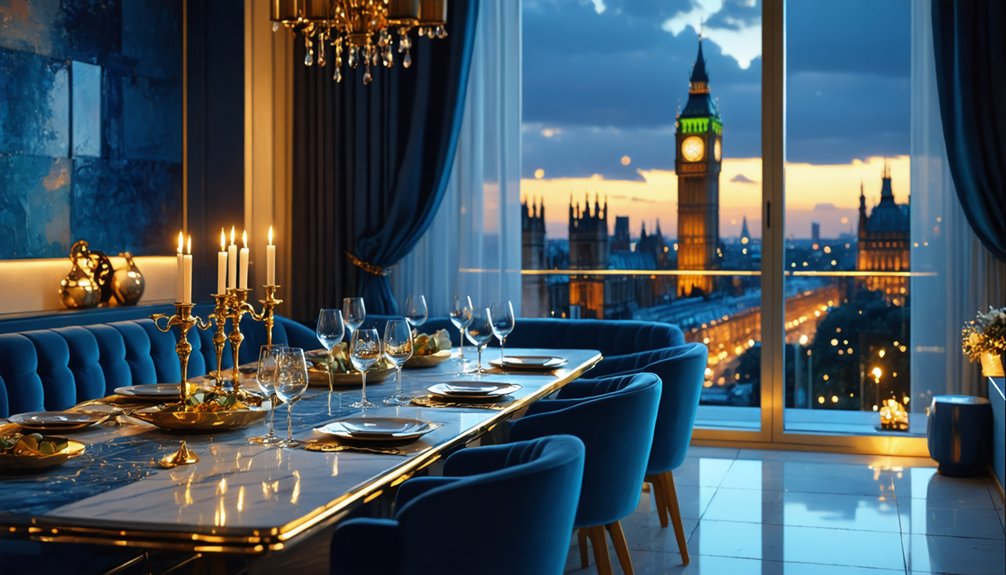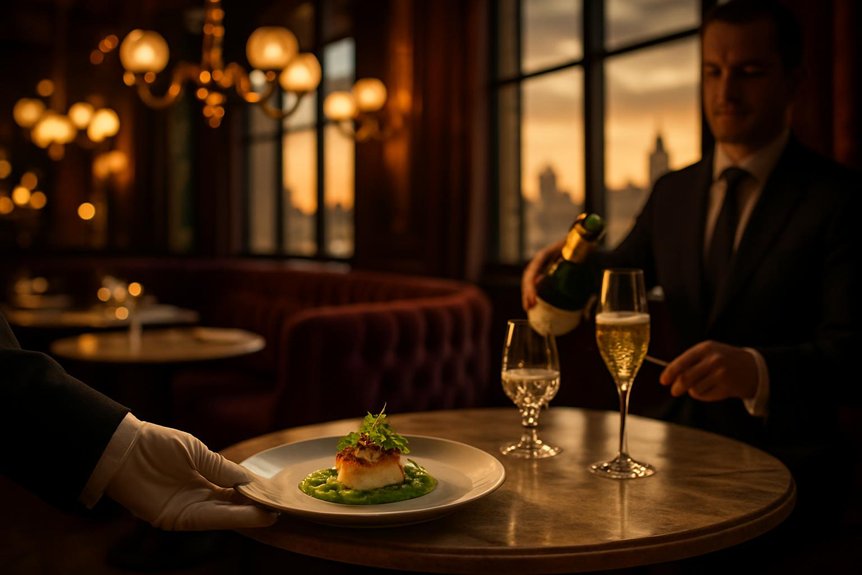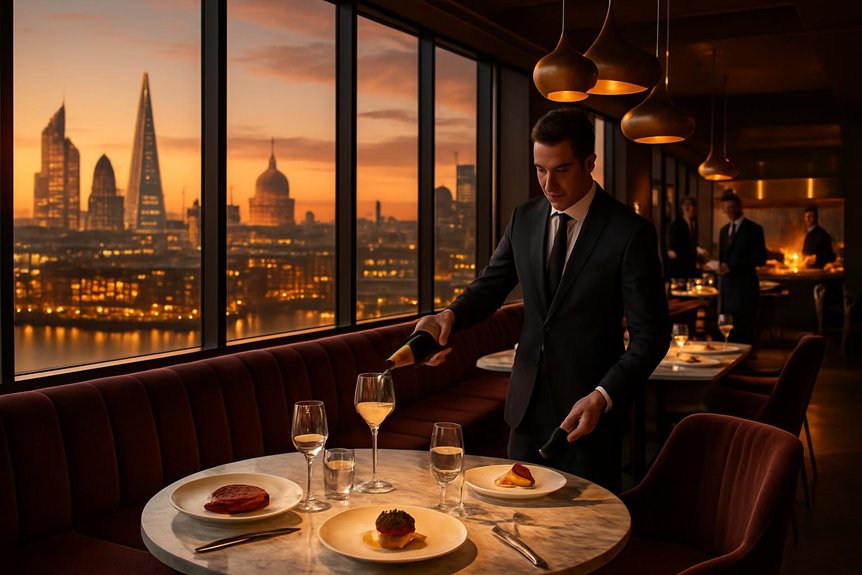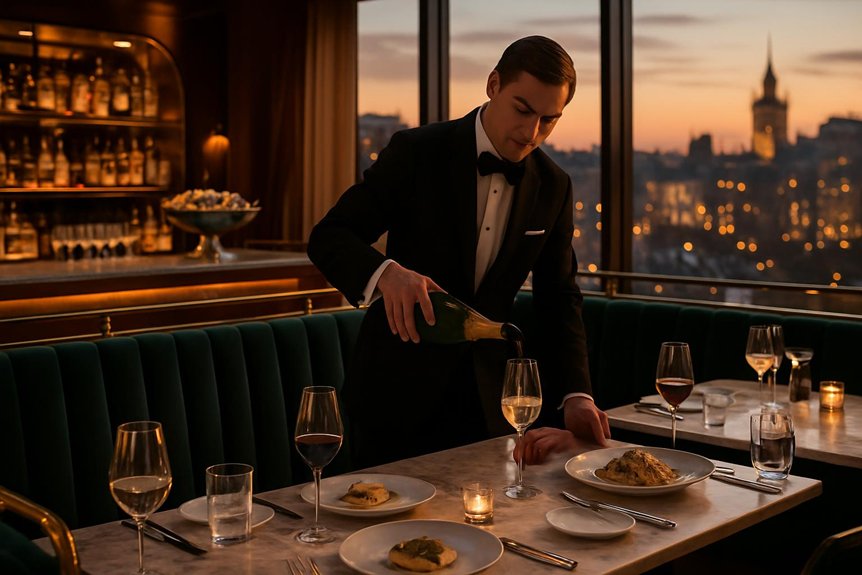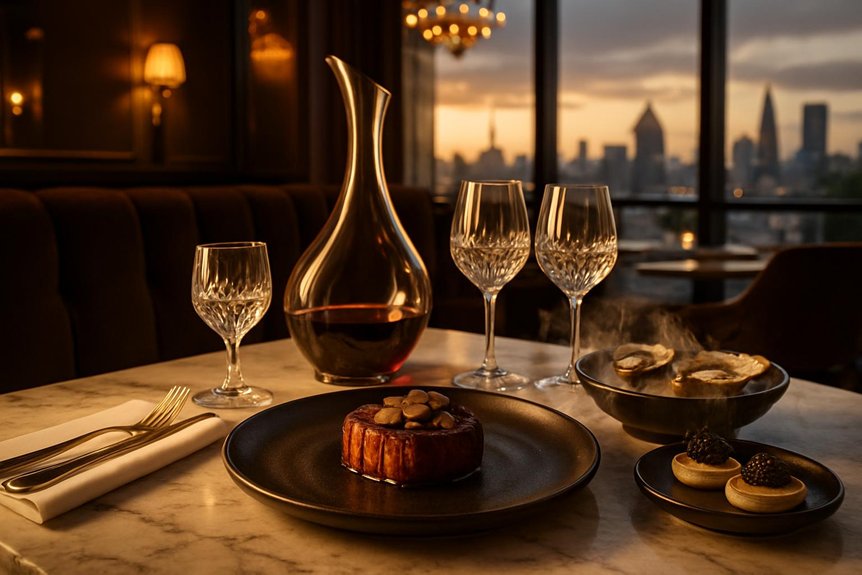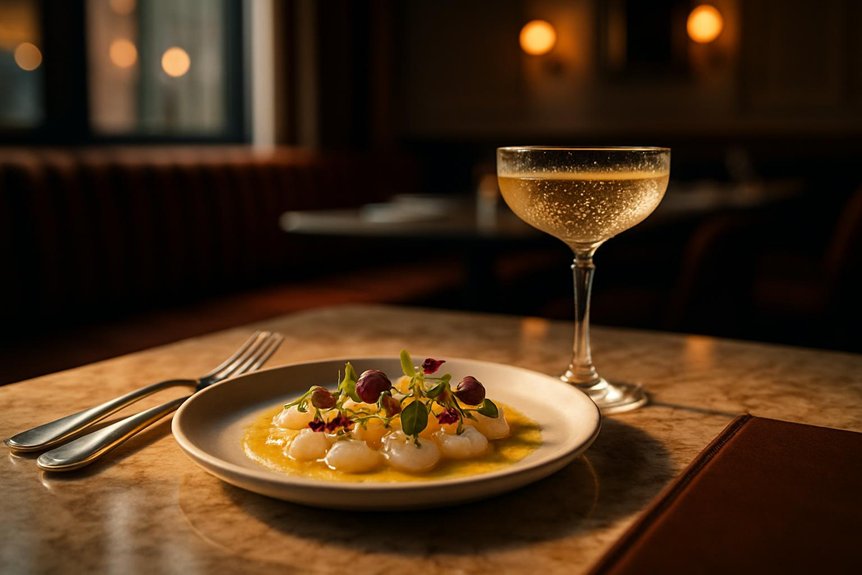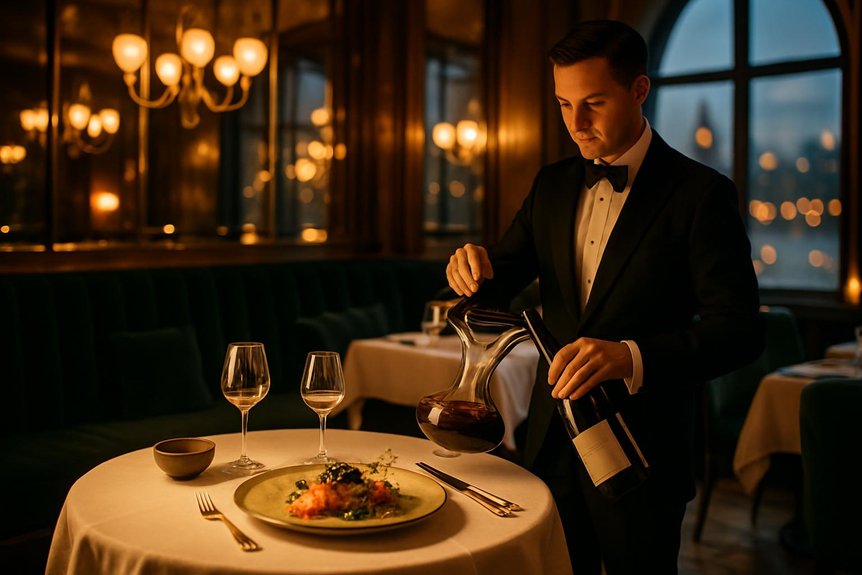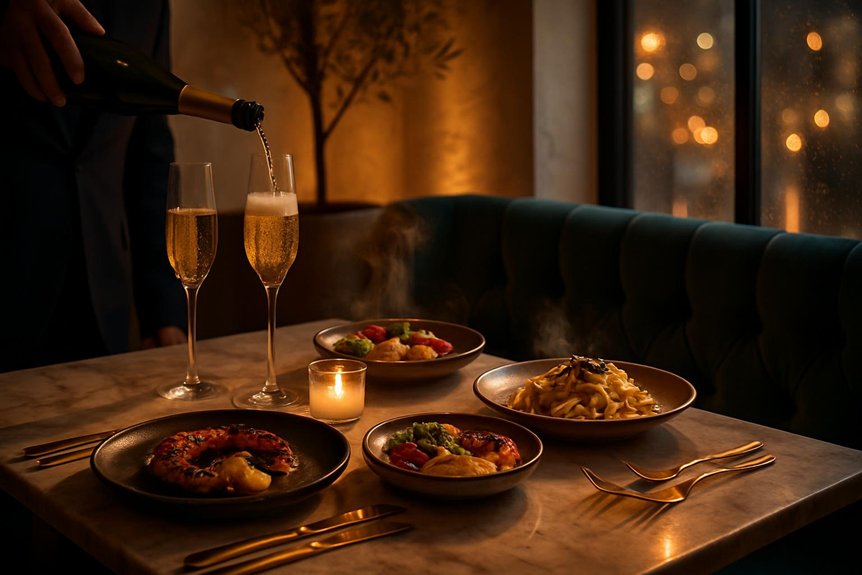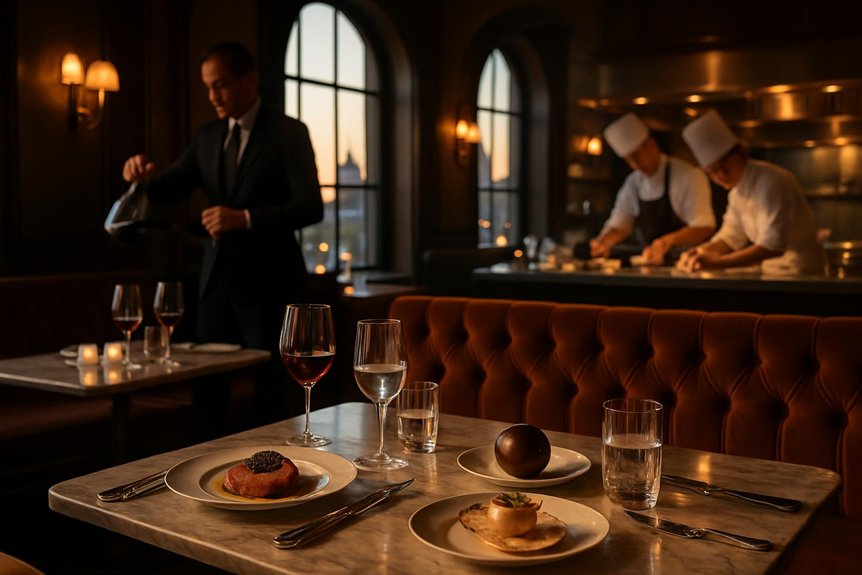In London’s most refined quarters, dining is an exercise in precision and restraint. Michelin-starred kitchens and discreet private rooms shape experiences that balance heritage with invention. Seasonal British produce, rare wines and exacting service create a calibrated elegance. The city’s culinary map rewards those who seek out craft and exclusivity, offering more than a meal—an invitation to discover what lies beyond the plate.
The Neighbourhoods That Define London’s Fine Dining Scene
London’s fine dining map is shaped as much by its neighbourhoods as by the chefs who populate them. Mayfair offers polished, heritage-backed restaurants. Soho pulses with adventurous small plates and late-night creativity. Chelsea blends polished service with refined, locally sourced menus.
Each district’s identity informs menu and atmosphere: neighbourhood history guides menu narratives and dining rituals. Local architecture dictates scale and intimacy. Georgian townhouses yield formal, candlelit rooms. Converted warehouses foster open kitchens and communal tables.
Dining corridors evolve around transport links, galleries and private clubs. These areas attract clientele whose expectations shape culinary offerings. Restaurateurs adapt to zoning, building constraints and listed facades, balancing innovation with respect for context.
They also work to preserve character while refining luxury. At Meraki Restaurant, guests can enjoy a vibrant atmosphere with dining and dancing, making it an ideal venue for special occasions and gatherings.
Michelin Stars and Modern British Cuisine
A constellation of Michelin stars has both codified and propelled Modern British cuisine into a global conversation, where chefs reinterpret native ingredients through techniques borrowed from Europe and beyond. The city’s starred venues balance respect for culinary heritage with forward-looking presentation: seasonal foraged produce, reimagined classics, and precise technique.
Artisanal chocolates appear alongside savory courses as refined interludes or inventive desserts, signaling craftsmanship beyond savory domains. Service remains calibrated to let ingredients speak, while menus shift to reflect provenance and sustainability.
- Husk of heritage: game, root vegetables, coastal fish elevated by contemporary technique.
- Sweet geometry: artisanal chocolates integrated into palate-cleansing and finale sequences.
- Sourcing maps: farms, foragers, and ethical fisheries supplying daily menus.
In the heart of London, Meraki offers a blend of contemporary luxury with authentic Mediterranean flavors, capturing the essence of modern elegance.
Chef’s Tables and Intimate Tasting Experiences
A private chef’s table offers a rare chance to observe culinary technique and to interact with the chef in an intimate setting.
Bespoke tasting menus tailor each course to seasonal produce and guest preferences, turning a meal into a curated narrative.
Together they transform dining into a personalised, memorable event distinct from standard restaurant service.
The cosmopolitan Greek atmosphere at Meraki in Fitzrovia exemplifies how ambiance can elevate a dining experience, making it suitable for special occasions or dates.
Private Chef’s Table
How does dining change when the chef becomes both host and performer? A Private Chef’s Table reframes service into a curated encounter where exclusive ingredients and chef collaborations define pace and personality. Guests witness technique, ask questions, and accept pacing set by culinary authority. Settings favor discreet rooms or kitchen counters; reservations are limited to preserve focus.
- Intimate choreography: plated courses presented with explanation and seasonal sourcing notes.
- Sensory control: lighting, music, and wine pairings adjusted to emphasize flavor arcs.
- Personal rapport: menus adapt subtly to preferences, allergies, and celebratory requests.
This format privileges direct exchange over anonymity, turning a meal into a memorable dialogue between maker and diner without reverting to spectacle or formal restaurant routines.
Bespoke Tasting Menus
Moving from the immediacy of a chef-hosted table, bespoke tasting menus expand the concept into orchestrated narratives across multiple courses. They present tightly choreographed progressions that balance texture, temperature and seasonality, often weaving farm to table sourcing with contemporary techniques.
Diners encounter intimate pacing: small plates that reveal provenance, palate cleansers that reset expectations, and a finale that reframes the meal’s theme. In London’s luxury scene, such menus can marry local British ingredients with global perspectives, producing restrained yet inventive fusion cuisine.
Service is discreet and informed, matching wine pairings and timing to each course. The result is an immersive, confidential experience where culinary storytelling replaces spectacle, leaving a clear impression of skill and intentionality.
Sommeliers, Wine Lists, and Rare Bottles
In London’s top dining rooms, sommeliers function as expert navigators, curating wine lists that balance classic vintages with experimental producers and guiding guests toward bottles that complement both menu and mood. They advise on wine collecting and cellar management for discerning patrons, source rare bottles through trusted contacts, and present tasting notes with precise restraint.
Lists often feature verticals, single-vineyard treasures, and contemporary natural wines, each paired to texture and seasoning rather than trend. The sommelier’s role extends to hosting private tastings and managing restaurant cellars to preserve provenance and value.
- Intimate sommelier-led tastings highlighting provenance and aging potential.
- Impeccably organized cellars with climate control and provenance records.
- Rare bottle showcases timed to seasonal tasting menus.
Luxury Hotel Restaurants and Destination Dining
Luxury hotels in London increasingly anchor their reputations on signature tasting menus that showcase seasonal British produce and creative technique.
Bespoke private dining options offer tailored menus, discreet service and exclusive settings for guests seeking privacy and personalization.
Culinary-led hotel bars complement these experiences with cocktail programmes and small plates designed by the same chefs, turning hotels into destination dining hubs.
Signature Tasting Menus
Five- to ten-course tasting menus in London’s top hotel restaurants distill a chef’s vision into a focused, meticulously paced experience that blends local ingredients, theatrical presentation, and service calibrated for refinement.
Diners move through seasonal progressions where seafood, charred vegetables, and rare game are sequenced to build momentum. Sommelier-led vineyard tour stories and thoughtful dessert pairing elevate each course without overshadowing technique. Kitchens balance restraint and surprise: a single fermented element, a smoke-scented course, or a delicate confection can define the evening.
Intimate dining rooms and open kitchens frame the narrative, while staff anticipate rhythm and temperature. The outcome is an immersive sequence that rewards attention and repeat visits, presenting London as a stage for culinary authorship.
- Seasonal progression and pacing
- Wine narratives and desserts
- Theatrical plating and service
Bespoke Private Dining
Many hotel restaurants now offer fully bespoke private dining that tailors menu, service, and setting to a client’s precise brief, transforming a meal into a curated event. These experiences prioritize intimacy and control: rooms are dressed to suit occasion and the dining ambiance is calibrated through lighting, sound and table composition.
Chefs collaborate on personalized menus, accommodating dietary needs, provenance requests and thematic preferences. Meticulous ingredient sourcing is presented as part of the narrative, with seasonal and rare items highlighted to enhance exclusivity.
Service teams rehearse timing and discreet attention, ensuring flow from arrival to farewell. Pricing reflects customization and rarity, while confidentiality and privacy protocols make such offerings attractive for celebrations, corporate hospitality and high-profile gatherings.
Culinary-Led Hotel Bars
How does a hotel bar become a culinary destination rather than just a prelude to dinner? The best transform through focused menus, chef-driven small plates and cocktail innovations that treat drinks as culinary creations. Attention to sourcing, seasonality and plating elevates snacks into tasting experiences; technique aligns with flavour to rival nearby restaurants.
Atmosphere matters: a refined bar lounge ambiance draws locals and guests alike, framing service that is simultaneously polished and inventive.
- Intimate counter seating where bartenders and chefs collaborate on live pairing.
- A tasting menu of small plates matched to signature cocktails emphasizing texture and aroma.
- Curated music, lighting and glassware that amplify scent perception and conviviality.
The result is a destination bar recognized for gastronomy and hospitality.
Contemporary Design and the Art of Atmosphere
What distinguishes contemporary London dining spaces is the deliberate choreography of light, material and sound to shape perception and mood. Designers integrate ambient lighting and sculpted acoustics with tactile finishes, framing tables so artistic plating becomes part of a spatial narrative.
Neutral palettes and bold accents guide attention; transparency, mirrors and curated voids expand intimacy without diminishing formality.
Furniture and service flow are calibrated to support rhythm—seating geometry, clear sightlines and discreet service points converge to minimize intrusion. Technology is subtle: climate control, responsive light scenes and unobtrusive audio adapt to courses and conversation.
The resulting atmosphere is intentionally composed, where aesthetic restraint amplifies culinary gestures and patrons experience dining as a coherent, immersive performance rather than a sequence of isolated moments.
Seafood, Game, and Seasons: Ingredients at the Fore
The composed atmosphere of contemporary London dining naturally extends into a kitchen philosophy where provenance, seasonality and provenance-focused techniques dictate menus. Chefs prioritize sustainable sourcing, balancing local fisheries and ethical game suppliers to showcase clear origin and minimal waste.
Seasonal pairings drive menu evolution: menus change with tides and fields, presenting fish when abundant, game in colder months, and vegetables that complete each course. Preparation emphasizes respect for ingredients—simple treatments that amplify texture and terroir without theatrical distraction.
- Line-caught fish with sea herbs and coastal salts, highlighting sustainable sourcing.
- Slow-roasted game with root purées and winter berries for measured seasonal pairings.
- Spring crudi, foraged greens, and bright dressings celebrating renewal and restraint.
Service Standards: From Reservation to Farewell
Service in London’s fine dining scene moves with quiet precision, guiding guests from the moment a reservation is made to the final goodbye. Reservations are handled with attentive clarity, confirming preferences and anticipating needs. Arrival protocols meld discreet greetings with swift seating. Throughout the meal, staff professionalism governs timing, technical service and unobtrusive explanations of dishes.
Luxury amenities — from cloakroom care to curated water and bespoke table linens — reinforce a sense of occasion without ostentation. Sommelier interactions and course pacing balance expertise with restraint, ensuring rhythm and comfort.
Bills and departures are managed promptly yet considerately, with sincere thanks and follow-up reservations offered when appropriate. The result is a seamless arc of hospitality that respects both time and taste.
Private Dining, Events, and Bespoke Menus
Private rooms and discreet settings offer guests intimate private dining experiences tailored to occasion and company.
Chefs and event planners collaborate to create tailored event menus that reflect seasonal produce, dietary needs, and thematic intent.
Front-of-house teams coordinate logistics and timing to guarantee seamless service from arrival to farewell.
Intimate Private Dining
An intimate private dining experience in London pairs discreet elegance with meticulous culinary planning, creating memorable gatherings for small groups or exclusive events. Hosts and chefs collaborate to define ambience, timing, and culinary flow while focusing on dish presentation and tableware design to elevate each course.
Service is unobtrusive yet attentive, ensuring conversation and pacing remain central. Locations range from secluded dining rooms and private club salons to curated hotel suites, each chosen for acoustics, lighting, and privacy.
- A candlelit salon with bespoke porcelain and minimalist cutlery, emphasizing texture and color.
- A chef’s table where courses arrive in sculpted arrangements tailored to the room.
- A private suite featuring modular tableware design for seamless course progressions.
Tailored Event Menus
Tailored event menus translate a host’s vision and guest preferences into a structured culinary narrative, balancing seasonal ingredients, dietary requirements, and the flow of an occasion.
Chefs collaborate with clients to define tone, pace, and thematic accents, crafting courses that move logically from light apertifs to richer mains and refined desserts.
Menus often feature fusion delights that juxtapose heritage techniques with contemporary flavours, providing surprise without alienating guests.
Attention to sourcing ensures peak freshness and provenance transparency.
Tasting previews and iterative adjustments refine portioning and seasoning.
Presentation receives equal scrutiny: plating artistry elevates each course into a memorable focal point while respecting service practicalities.
The result is a bespoke dining experience aligned to purpose, scale, and guest expectations.
Seamless Service Coordination
When service teams synchronize timing, staffing, and communication protocols from rehearsal to final course, guests experience a fluid event where logistics vanish behind hospitality. The establishment coordinates private dining, events, and bespoke menus through personalized assistance and detailed logistics, ensuring each choreography and presentation is unobtrusive.
Staff execute cues with discreet efficiency; chefs time plates to arrivals; managers monitor pacing and guest needs. Outcomes emphasize comfort, rhythm, and elevated impression rather than spectacle. Success depends on pre-event planning, technology-enabled coordination, and trained personnel who anticipate requests.
- Venue staging: precise placements, lighting, and service flow planned.
- Staffing choreography: role assignments, timing sheets, and contingency coverage.
- Culinary timing: synchronized plating, temperature control, and guest-specific adjustments.
Emerging Talent and the Next Wave of Culinary Innovators
How are London’s kitchens reshaping the city’s culinary identity? Attention turns to emerging chefs who merge molecular gastronomy techniques with street food roots, producing refined yet approachable plates.
These innovators train in classics, then pivot—testing fermentation, spherification and smoke alongside halal carts and pop-up stalls. Investors and luxury restaurants scout talent from markets and culinary schools, offering residencies and experimental menus.
Critics note a shift: prestige now rewards creativity, sustainability and provenance as much as tradition. Collaboration between tech-minded chefs and seasoned restaurateurs accelerates concept incubation.
As mentorship programs expand, a new generation refines service standards and ethical sourcing, ensuring London’s gastronomic future blends audacity with responsibility, attracting global acclaim.
Conclusion
In London’s gilded kitchens and hushed dining rooms, luxury and craft entwine like ivy on historic brick, each plate a small cathedral of season and skill. Diners become pilgrims, moving through neighborhoods that whisper of tradition and flash of daring, while chefs, sommeliers and hoteliers compose nocturnes of taste. Here gastronomy is both heirloom and prophecy—an immersive theatre where every bite reverberates, promising memory, rarity and the quiet thunder of culinary mastery.
